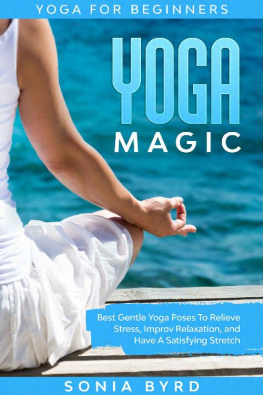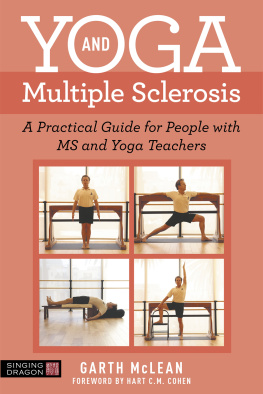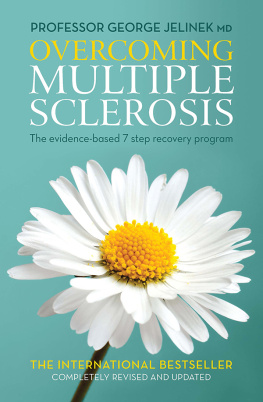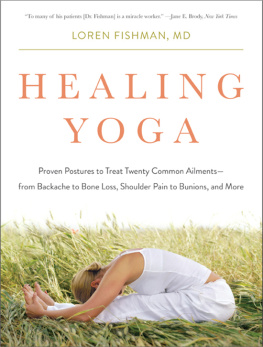Yogaand Multiple Sclerosis
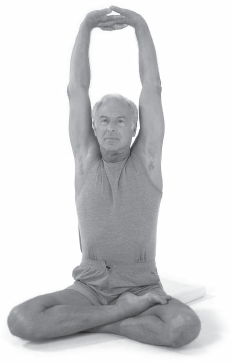
Yoga and Multiple Sclerosis
A Journey To
Health And Healing
LOREN M. FISHMAN, M.D.
ERIC L. SMALL


Special discounts on bulk quantities of Demos Medical Publishing books
are available to corporations, professional associations, pharmaceutical companies,
health care organizations, and other qualifying groups. For details, please contact:
Special Sales Department
DEMOS MEDICAL PUBLISHING
386 Park Avenue South, Suite 301
New York, NY 10016
Phone: 800-532-8663, 212-683-0072
Fax: 212-683-0118
Email: specialsales@demosmedpub.com

Visit our website at www.demosmedpub.com
2007 by Demos Medical Publishing, LLC. All rights reserved.
This book is protected by copyright. No part of it may be reproduced,
stored in a retrieval system, or transmitted in any form or by any means,
electronic, mechanical, photocopying, recording, or otherwise,
without the prior written permission of the publisher.
LIBRARY OF CONGRESS CATALOGING-IN-PUBLICATION DATA
Fishman, Loren M.
Yoga and multiple sclerosis : a journey to health and healing/Loren
M. Fishman, Eric L. Small.
p. ; cm.
Includes bibliographical references and index.
ISBN-13: 978-1-932603-17-0 (pbk. : alk. paper)
ISBN-10: 1-932603-17-4 (pbk. : alk. paper)
1. Multiple sclerosisPatientsRehabilitation. 2. YogaTherapeutic
use. I. Small, Eric L. II. Title.
[DNLM: 1. Multiple Sclerosisrehabilitation. 2. Yoga. WL 360
F537y 2007]
RC377.F57 2007
616.834062dc22
2006030464
Designed by Steven Pisano
07 08 09 10 11 5 4 3 2 1

Dedication
Mr. Iyengar has led the quest for the authentic yoga of
antiquity no less than for its refinement and adaptation
to current times and the needs of living people. As a
teacher and researcher, a creative and disciplined leader,
a conceptual inventor and a physical presence in classes
and out, he is our master. To express our intellectual
debt and heartfelt gratitude to Mr. Iyengar, language
fails. But it is easy to state that the authors are fully
responsible for everything in this book.


Preface
I t is paradoxical that yoga, thousands of years old and originating in India, a warm country where multiple sclerosis is almost nonexistent, is both utterly contemporary and of great benefit in the treatment of multiple sclerosis (MS). Fatigued by modern medicines sharp compartmentalization, contemporary medicine has rebelled and claims interest in the whole person. Yoga and its goals have always addressed the whole person; there is no such thing as yoga of the thigh.
But there are also distinct differences between medicine and yoga. With the ex ception of public health, medicine is only brought in when things go wrong, and only until the status quo has been reached again. Yoga, always concerned with the individual, takes up for no reason at any stage along the continuum of health and disease, and does not relinquish its hold when illness does. On the contrary, it continues to take practit ioners beyond mere absence of disease toward a goal of wisdom and peace.
Yoga is not science. The constellation of physics, chemistry, and biology, from which medicine is an offspring, gathers data empirically and uses logical methods of proof. Empirical and deductive means combine to determine the diagnoses and progress of individuals. If yoga is to be rationally valued, it must be evaluated in terms of the sciences: it will not do anyone any good to conclude that yoga is beneficial in MS because more people learn to do the shoulder stand. They must be shown to ambulate more safely, have better visual evoked potentials, or score better on the Kurtzke Scale. Sciences services are then needed again to explain how yoga works.
Yoga is changing along with the global culture of which it forms a part. While yoga has been passed on from teacher or guru to individual student for all of its many generations, todays mobile societies require a certification program to distinguish the serious practitioner from other types. There are a large number of written texts, movies, tapes, videos, and web sites, but it is part of the credo of yoga that it actually be taught.
The precious gift that Mr. B. K. S. Iyengar has given us, in the form of his work and the distinguished striving his life represents, has enabled large numbers of people to avail themselves of a very refined and detailed teaching that would not have been possible using the old-time methods. Many quotes, techniques, and almost all the poses in this book derive from his books and teaching.
In this context, this book is offered as a guide and helpmate to those who would use yoga, be they physicians, physical therapists, nurses, parents, children, students or, perchance, teachers.
The book is divided into two sections: the first is a straightforward but gentle introduction to yoga for people with significant MS involvement. It is a therapeutic approach to the practice itself. Without this, the rest of the book might be just an academic exercise.
The second part is functionally oriented: different yoga poses are assembled that work toward a common goal, such as combating fatigue, reducing spasticity, and increasing range of motion. It is intended for people with MS and other neurological conditions, people who undertake yoga on their own, and for members of the medical and yoga communities. It begins with a more detailed analysis of how yoga appears to work: describing basic physiological means by which it helps people with MS and similarly afected patients. It then sorts out which poses are helpful for which conditions, and it guides teachers, students, and patients on how to use the physiological considerations to adapt the poses to individual patients needs. It is intended for people that have or readily could have completed Part I.
Yoga was begun thousands of years ago as the science of quieting the mind. Patanjali, the man attributed authorship of the first text on yoga, was also the first grammarian and a physician. His Yoga Sutras (Threads of Yoga) begins, Yoga chitta-vritti-nirodhah, Yoga is inhibition of different states of mind. The goal of a completely unmodified consciousness pervades every aspect of yoga. It is held up as the best arbiter for individual decision-making and the ultimate aim of life. The idea is that an unprejudiced and unemotional examination of a situation is the most successful. Yet the principle of unattached evaluation is itself recommended not on empirical or rational but rather on intuitive grounds. The science of yoga has never endeavored to prove the value of nonattachment. Those who value yoga simply believe it.



